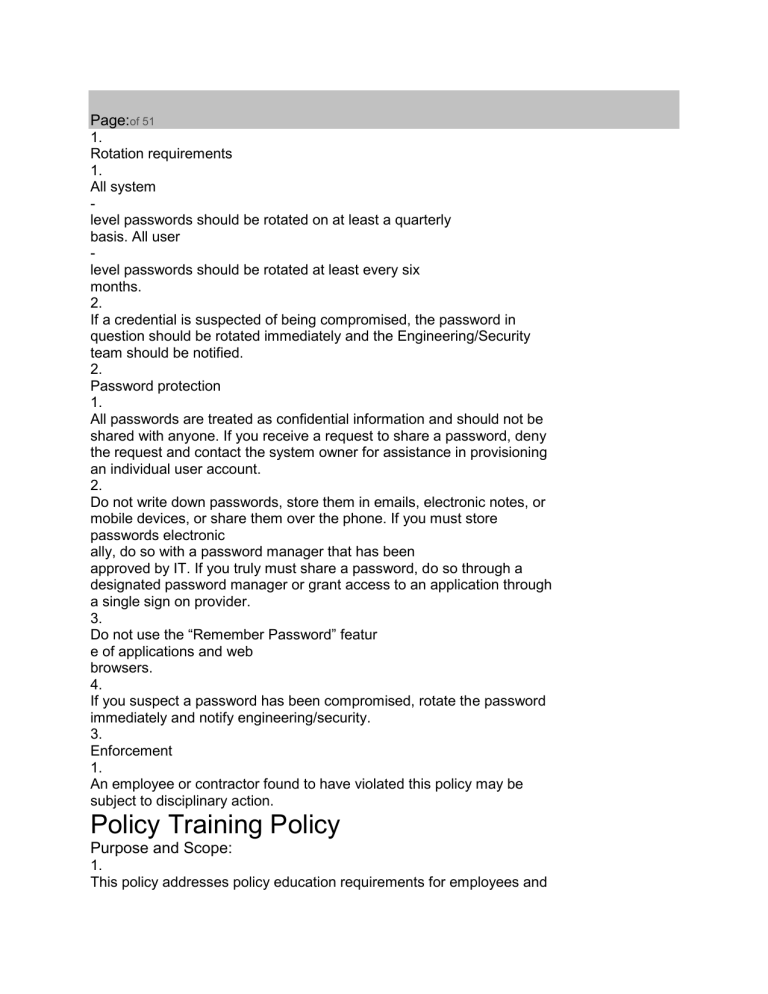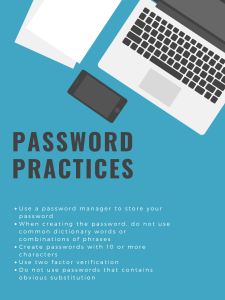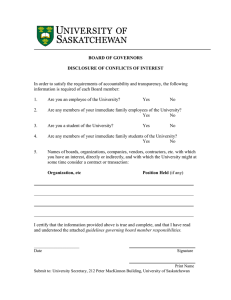
Page:of 51 1. Rotation requirements 1. All system level passwords should be rotated on at least a quarterly basis. All user level passwords should be rotated at least every six months. 2. If a credential is suspected of being compromised, the password in question should be rotated immediately and the Engineering/Security team should be notified. 2. Password protection 1. All passwords are treated as confidential information and should not be shared with anyone. If you receive a request to share a password, deny the request and contact the system owner for assistance in provisioning an individual user account. 2. Do not write down passwords, store them in emails, electronic notes, or mobile devices, or share them over the phone. If you must store passwords electronic ally, do so with a password manager that has been approved by IT. If you truly must share a password, do so through a designated password manager or grant access to an application through a single sign on provider. 3. Do not use the “Remember Password” featur e of applications and web browsers. 4. If you suspect a password has been compromised, rotate the password immediately and notify engineering/security. 3. Enforcement 1. An employee or contractor found to have violated this policy may be subject to disciplinary action. Policy Training Policy Purpose and Scope: 1. This policy addresses policy education requirements for employees and contractors. 2. This policy applies to all full time employees, part time employees, and contractors. Adherence to assigned policies is binding under their Employment Offer Letter and/or Independent Contractor Agreement. Applicability: 1. Upon hire of a new employee or contr actor, the Hiring Manager will determine which subsets of policies will apply to that individual. The individual will have five working days to read the assigned policies. The following will be logged in the Policy Training Policy Ledger: 1. Assignment date 2. C ompletion date 3. Policy 4. Assignee 5. Assigner 6. Notes Remote Access Policy Purpose and Scope: 1. The purpose of this policy is to define requirements for connecting to the organization’s systems and networks from remote hosts, including personally owned devices, in order to minimize data loss/exposure. 2. This policy applies to all users of information systems within the organization. This typically includes employees and contractors, as well as any external parties that come into contact with systems and information c ontrolled by the organization (hereinafter referred to as “users”). This policy must be made readily accessible to all users. Background 1. The intent of this policy is to minimize the organization’s exposure to damages which may result from the unauthorized remote use of resources, including but not limited to: the loss of sensitive, company confidential data and intellectual property; damage to the organization’s public image; damage to the organization’s internal systems; and fines and/or other financial li abilities incurred as a result of such losses. 2. Within this policy, the following definitions apply: 1. Mobile computing equipment: includes portable computers, mobile phones, smart phones, memory cards and other mobile equipment used for storage, processing a nd transfer of data. 2. Remote host: is defined as an information system, node or network that is not under direct control of the organization. 3. Telework: the act of using mobile computing equipment and remote hosts to perform work outside the organization’s p hysical premises. Teleworking does not include the use of mobile phones. Policy 1. Security Requirements for Remote Hosts and Mobile Computing Equipment 1. Caution must be exercised when mobile computing equipment is placed or used in uncontrolled spaces such as vehicles, public spaces, hotel rooms, meeting places, conference centers, and other unprotected areas outside the organization’s premises. 2. When using remote hosts and mobile computing equipment, users must take care that information on the device (e.g. displayed on the screen) cannot be read by unauthorized persons if the device is being used to connect to the organization’s systems or work with the or ganization’s data. 3. Remote hosts must be updated and patched for the latest security updates on at least a monthly basis. 4. Remote hosts must have endpoint protection software (e.g. malware scanner) installed and updated at all times. 5. Persons using mobile com puting equipment off premises are responsible for regular backups of organizational data that resides on the the device. 6. Access to the organization’s systems must be done through an encrypted and authenticated VPN connection with multi factor authenticatio n enabled. All users requiring remote access must be provisioned with VPN credentials from the organization’s information technology team. VPN keys must be rotated at least twice per year. Revocation of VPN keys must be included in the Offboarding Policy. 7. Information stored on mobile computing equipment must be encrypted using hard drive full disk encryption. 2. Security Requirements for Telework 1. Employees must be specifically authorized for telework in writing from their hiring manager . 2. Only device’s assigne d owner is permitted to use remote nodes and mobile computing equipment. Unauthorized users (such as others living or working at the location where telework is performed) are not permitted to use such devices. 3. Devices must be authorized using certificates 4. Users performing telework are responsible for the appropriate configuration of the local network used for connecting to the Internet at their telework location. 5. Users performing telework must protect the organization’s intellectual property rights, either for software or other materials that are present on remote nodes and mobile computing equipment. Data Retention Policy Purpose and Scope: 1. This data retention policy defines the objectives and requirements for data retention within the organization. 2. This policy covers all data within the organization’s custody or control, irregardless of the medium the data is stored in (electronic form, paper form, etc.) Within this policy, the medium which holds data is referred to as information, no matter what for m it is in. 3. This policy applies to all users of information systems within the organization. This typically includes employees and contractors, as well as any external parties that come into contact with systems and information the organization owns or con trols (hereinafter referred to as “users”). This policy must be made readily available to all users. Background 1. The organization is bound by multiple legal, regulatory and contractual obligations with regard to the data it retains. These obligations stipul ate how long data can be retained, and how data must be destroyed. Examples of legal, regulatory and contractual obligations include laws and regulations in the local jurisdiction where the organization conducts business, and contracts made with employees, customers, service providers, partners and others. 2. The organization may also be involved in events such as litigation or disaster recovery scenarios that require it to have access to original information in order to protect the organization’s interests or those of its employees, customers, service provider s, partners and others. As a result, the organization may need to archive and store information for longer that it may be needed for day to day operations. Policy 1. Information Retention 1. Retention is defined as the maintenance of information in a production or live environment which can be accessed by an authorized user in the ordinary course of business. 2. Information used in the development, staging, and testing of systems shall not be retained beyond their active use period nor copied into production or live environments. 3. By default, the retention period of information shall be an active use period of exactly two years from its creation unless an exception is obtained permitting a longer or shorter retention period. The business unit responsible for the infor mation must request the exception. 4. After the active use period of information is over in accordance with this policy and approved exceptions, information must be archived for a defined period. Once the defined archive period is over, the information must b e destroyed. 5. Each business unit is responsible for the information it creates, uses, stores, processes and destroys, according to the requirements of this policy. The responsible business unit is considered to be the information owner. 6. The organization’s l egal counsel may issue a litigation hold to request that information relating to potential or actual litigation, arbitration or other claims, demands, disputes or regulatory action be retained in accordance with instructions from the legal counsel. 7. Each em ployee and contractor affiliated with the company must return information in their possession or control to the organization upon separation and/or retirement. 8. Information owners must enforce the retention, archiving and destruction of information, and com municate these periods to relevant parties. 2. Information Archiving 1. Archiving is defined as secured storage of information such that the information is rendered inaccessible by authorized users in the ordinary course of business but can be retrieved by an ad ministrator designated by company management. 2. The default archiving period of information shall be 7 years unless an approved exception permits a longer or shorter period. Exceptions must be requested by the information owner. 3. Information must be destroyed (defined below) at the end of the elapsed archiving period. 3. Information Destruction 1. Destruction is defined as the physical or technical destruction sufficient to render the information contained in the document irretrievable by ordinary commercially avail able means. 2. The organization must maintain and enforce a detailed list of approved destruction methods appropriate for each type of information archived, whether in physical storage media such as CD ROMs, DVDs, backup tapes, hard drives, mobile devices, po rtable drives or in database records or backup files. Physical information in paper form must be shredded using an authorized shredding device; waste must be periodically removed by approved personnel. 4. Retention and archival periods for information that is created, processed, stored and used by the organization is defined internally. Risk Assessment Policy Purpose and Scope: 1. The purpose of this policy is to define the methodology for the assessment and treatment of information security risks within th e organization, and to define the acceptable level of risk as set by the organization’s leadership. 2. Risk assessment and risk treatment are applied to the entire scope of the organization’s information security program, and to all assets which are used with in the organization or which could have an impact on information security within it. 3. This policy applies to all employees of the organization who take part in risk assessment and risk treatment. Background A key element of the organization’s information security program is a holistic and systematic approach to risk management. This policy defines the requirements and processes for the organization to identify information security risks. The process consists of four parts: identification of the organization’s assets, as well as the threats and vulnerabilities that apply; assessment of the likelihood and consequence (risk) of the threats and vulnerabilities being realized, identification of treatment for each u nacceptable risk, and evaluation of the residual risk after treatment. Policy 1. Risk Assessment 1. The risk assessment process includes the identification of threats and vulnerabilities having to do with company assets. 2. The first step in the risk assessment is to identify all assets within the scope of the information security program; in other words, all assets which may affect the confidentiality, integrity, and/or availability of information in the organization. Assets may include documents in paper or electr onic form, applications, databases, information technology equipment, infrastructure, and external/outsourced services and processes. For each asset, an owner must be identified. 3. The next step is to identify all threats and vulnerabilities associated with each asset. Threats and vulnerabilities must be listed in a risk assessment table. Each asset may be associated with multiple threats, and each threat may be associated with multiple vulnerabilities. A sample risk assessment table is provided as part of th e Risk Assessment Report Template (reference (a)). 4. For each risk, an owner must be identified. The risk owner and the asset owner may be the same individual. 5. Once risk owners are identified, they must assess: 6. The risk level is calculated by adding the cons equence score and the likelihood score. Description of Consequence Levels and Criteria: Description of Likelihood Levels and Criteria: 1. Risk Acceptance Criteria 1. Risk values 0 through 2 are considered to be acceptable risks. 2. Risk values 3 and 4 are considered to be unacceptable risks. Unacceptable risks must be treated. 2. Risk Treatment 1. Risk treatment is implemented through the Risk Treatment Table. All risks from the Risk Assessment Table must be copied to the Risk Treatment Ta ble for disposition, along with treatment options and residual risk. A sample Risk Treatment Table is provided in reference (a). 2. As part of this risk treatment process, the CEO and/or other company managers shall determine objectives for mitigating or trea ting risks. All unacceptable risks must be treated. For continuous improvement purposes, company managers may also opt to treat other risks for company assets, even if their risk score is deemed to be acceptable. 3. Treatment options for risks include the fol lowing options: 4. After selecting a treatment option, the risk owner should estimate the new consequence and likelihood values after the planned controls are implemented. 3. Regular Reviews of Risk Assessment and Risk Treatment 1. The Risk Assessment Table and Risk Treatment Table must be updated when newly identified risks are identified. At a minimum, this update and review shall be conducted once per year. It is highly recommended that the Risk Assessment and Risk Treatment Table be updated when significant changes occur to the organization, technology, business objectives, or business environment. 4. Reporting 1. The results of risk assessment and risk treatment, and all subsequent reviews, shall be documented in a Risk Assessment Repo rt. Vendor Management Policy Purpose and Scope: 1. This policy defines the rules for relationships with the organization’s Information Technology (IT) vendors and partners. 2. This policy applies to all IT vendors and partners who have the ability to impact t he confidentiality, integrity, and availability of the organization’s technology and sensitive information, or who are within the scope of the organization’s information security program. 3. This policy applies to all employees and contractors that are respon sible for the management and oversight of IT vendors and partners of the organization. Background The overall security of the organization is highly dependent on the security of its contractual relationships with its IT suppliers and partners. This policy defines requirements for effective management and oversight of such suppliers and partners from an information security perspective. The policy prescribes minimum standards a vendor must meet from an information security standpoint, including security clau ses, risk assessments, service level agreements, and incident management. Policy 1. IT vendors are prohibited from accessing the organization’s information security assets until a contract containing security controls is agreed to and signed by the appropria te parties. 2. All IT vendors must comply with the security policies defined and derived from the Information Security Policy (reference (a)). 3. All security incidents by IT vendors or partners must be documented in accordance with the organization’s Security I ncident Response Policy (reference (b)) and immediately forwarded to the Information Security Manager (ISM). 4. The organization must adhere to the terms of all Service Level Agreements (SLAs) entered into with IT vendors. As terms are updated, and as new one s are entered into, the organization must implement any changes or controls needed to ensure it remains in compliance. 5. Before entering into a contract and gaining access to the parent organization’s information systems, IT vendors must undergo a risk asses sment. 1. Security risks related to IT vendors and partners must be identified during the risk assessment process. 2. The risk assessment must identify risks related to information and communication technology, as well as risks related to IT vendor supply chains , to include sub suppliers. 6. IT vendors and partners must ensure that organizational records are protected, safeguarded, and disposed of securely. The organization strictly adheres to all applicable legal, regulatory and contractual requirements regarding t he collection, processing, and transmission of sensitive data such as Personally Identifiable Information (PII). 7. The organization may choose to audit IT vendors and partners to ensure compliance with applicable security policies, as well as legal, regulato ry and contractual obligations. Workstation Policy Purpose and Scope: 1. This policy defines best practices to reduce the risk of data loss/exposure through workstations. 2. This policy applies to all employees and contractors. Workstation is defined as the collection of all company owned and personal devices containing company data. Policy: 1. Workstation devices must meet the following criteria: 1. Operating system must be no more than one generation older than current 2. Device must be encrypted at rest 3. Device must be locked when not in use or when employee leaves the workstation 4. Workstations must be used for authorized business purposes only 5. Loss or d estruction of devices should be reported immediately 6. Laptops and desktop devices should run the latest version of antivirus software that has been approved by IT 2. Desktop & laptop devices 1. Employees will be issued a desktop, laptop, or both by the company, b ased on their job duties. Contractors will provide their own laptops. 2. Desktops and laptops must operate on macOS or Windows. 3. Mobile devices 1. Mobile devices must be operated as defined in the Removable Media Policy, Cloud Storage, and Bring Your Own Device P olicy. 2. Mobile devices must operate on iOS or Android. 3. Company data may only be accessed on mobile devices with Slack and Gmail. 4. Removable media 1. Removable media must be operated as defined in the Removable Media Policy, Cloud Storage, and Bring Your Own Dev ice Policy. 2. Removable media is permitted on approved devices as long as it does not conflict with other policies.

